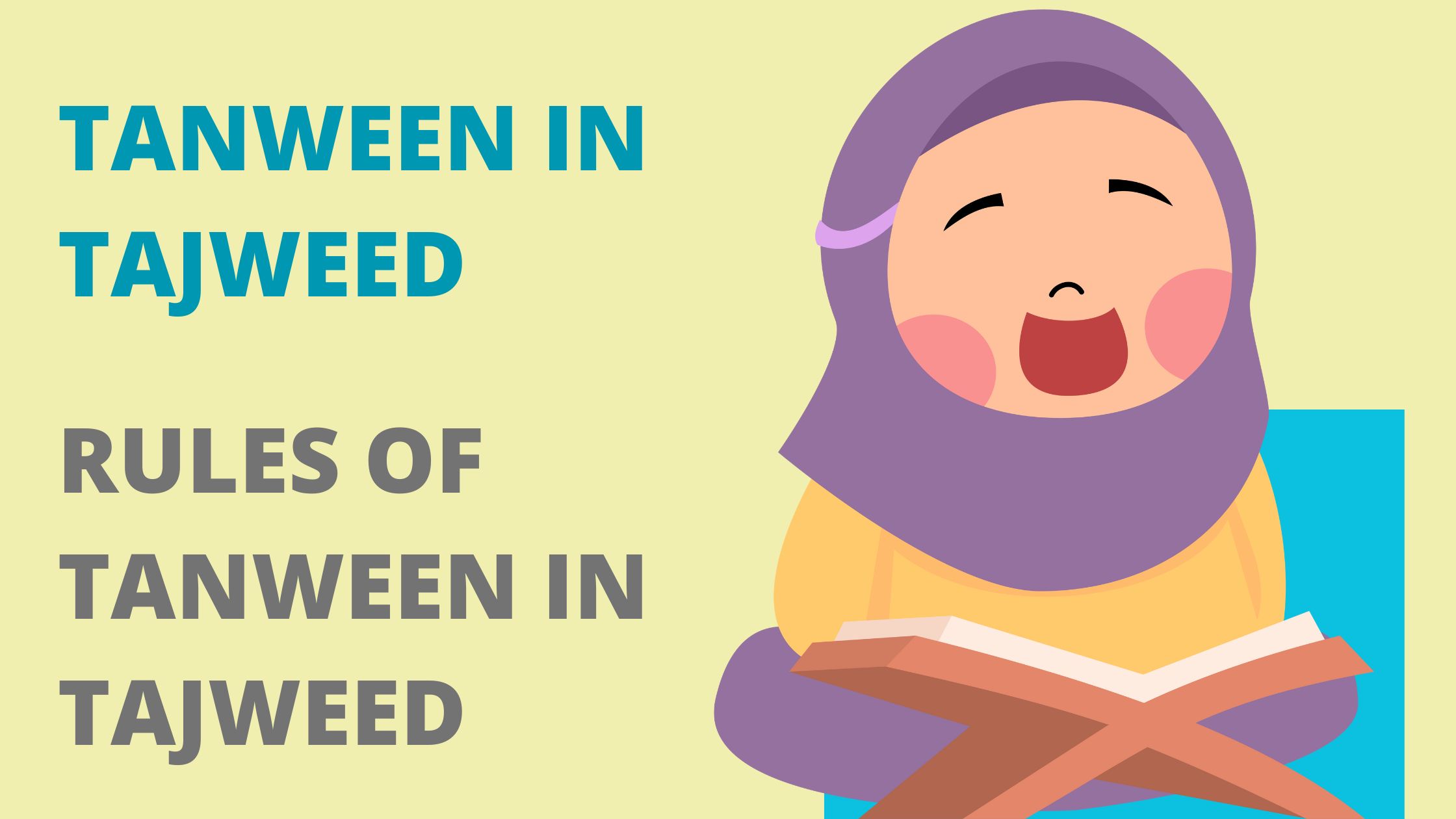In this blog post, we will discuss what Tanween is, examine its different types and symbols, give examples from the Quran, and help you become proficient in Tajweed.
Tanween refers to the diacritical marks placed above certain Arabic letters in the Quran that are essential for correct recitation and comprehension of Tajweed. Both novice and advanced students must have a thorough understanding of Tanween and its regulations.
Table of Contents
What is Tanween in the Quran?
In basic terms, Tanween refers to the short vowel sounds that are added at the end of certain words in Arabic grammar. Tanween is an essential concept in the study of Tajweed, which emphasizes correct pronunciation and recitation of the Quran.
These short vowels help determine how a word should be pronounced and give it a specific grammatical meaning. By studying and implementing them, individuals can enhance their proficiency in reading and comprehending the Quran.
If you’re interested in helping your kids learn the Quran online with Tajweed for kids, consider enrolling them at Bayan Al-Quran Academy. Our experienced teachers and interactive teaching methods help kids excel in Tajweed and Quranic studies. Click here to learn more and enroll now!
Definition of Tanween in Arabic
In Arabic, “tanween” refers to the addition of a vowel sound at the end of a word. It is represented by three small symbols known as “tanween signs,” which indicate different vowel sounds – fathah (short ‘a’ sound), kasrah (short ‘i’ sound), and dammah (short ‘u’ sound).
Tanween is an important aspect of Arabic grammar with various functions, such as indicating indefinite nouns or adjectives, denoting plurality, and distinguishing between grammatical cases.
Tanween Symbol
The Tanween symbol is a crucial component in Tajweed, representing the sound of “n” followed by a short vowel. It appears as a small diagonal line on top of each letter or as two dots placed above it. Here are some key points about the Tanween symbol:
- The Arabic script does not include vowels; therefore, the Tanween symbol helps indicate the presence of short vowels.
- The Tanween symbols include three variations: Fathah (ً), Kasrah (ٍ), and Dammah (ٌ).
- Each variation represents different short vowel sounds: -an for Fathah, -in for Kasrah, and -un for Dammah.
- The placement of the Tanween symbol varies depending on whether it follows a space or another letter.
Understanding how to correctly pronounce words with the Tanween symbol is essential in reciting the Quran accurately according to Tajweed rules.
Learn All about Madd:
The Rules of Tanween in Tajweed
The rules of Tanween in Tajweed are essential for accurately reciting the Quran. Four main rules dictate the pronunciation and use of Tanween: Izhar, Iqlab, Idghaam, and Ikhfaa. These rules aid in achieving precise recitation according to Tajweed principles:
1. Izhar of Tanween
The term “Izhar of Tanween” refers to the proper enunciation of the tanween (also known as nunation) in Tajweed. This occurs when a tanween is followed by a letter from the group consisting of Hamza ( ء ), Haa ( ه ), Ayn ( ع ), Haa ( ح ), Ghayn ( غ ), and Khaa ( خ ) and is pronounced clearly without any nasal sound.
In other words, there is no merging or blending between the tanween and the following letter. The tanween is pronounced distinctly and separately before moving on to pronounce the next letter.
Examples of Tanween Ikhfaa
An example of the rule of Izhar of Tanween can be seen in the phrase “يَوْمٍ عَظِيمٍ” (yawmin ‘aẓīmin). When applying this rule, the Tanween at the end of “يَوْمٍ” is pronounced openly, and the following letter “Ayn” does not affect its pronunciation.
2. Iqlab of Tanween
Iqlaab is a Tajweed rule that involves converting Tanween into the letter Meem (م) without any Harakah when it precedes the letter Baa (ب). Iqlaab is always accompanied by Ghunnah, a nasal sound lasting two beats. The only letter that triggers Iqlaab is Baa. When Baa follows Tanween, the Tanween is converted into Meem.
Examples of Tanween Iqlab
An example is the phrase “لَنَسْفَعًا بِالنَّاصِيَةِ” (Lanasfa’aan bin-naasiyati), where the Tanween at the end of the verb undergoes Iqlaab because of the following letter Baa. This is an exception for verbs with Tanween.
3. Idghaam of Tanween
Idgham is a Tajweed rule that involves merging the pronunciation of Tanween with one of the Idhaam letters, resulting in the formation of a single Mushaddad letter. This Mushaddad letter has the sound of a Mutaharrik letter.
It is important to note that Idgham may or may not be accompanied by Ghunnah, which is a sound originating from the nose, depending on the specific Idgham letter used.
Letters of Tanween Idghaam
There are six letters of Idgham in the Arabic Alphabet: Yaa (ي), Raa (ر), Meem (م), Laam (ل), Waw (و), and Noon (ن). These letters are Mutaharrik letters, meaning they have a Harakah.
Examples of Tanween Idghaam
When these Idgham letters follow Tanween, the rule of Idgham applies. An example of this can be seen in the phrase “مالٍ وَبَنِينَ” (maalin wabanīna), where the Tanween at the end of the word “مالٍ” is followed by the letter Waw in the next word.
4. Ikhfaa of Tanween
Ikhfaa of Tanween is a Tajweed rule that involves hiding or preventing the clear pronunciation of the Tanween (double vowel sound) when it is followed by certain letters called Ikhfaa letters. The term “Ikhfaa” literally means to hide or prevent something from appearing. In Tajweed, Ikhfaa refers to hiding the Tanween from clear pronunciation.
During Ikhfaa, the Tanween is not pronounced clearly but is also not completely blended into the following letter. Instead, it is in an intermediate phase between Izhaar (clear pronunciation) and Idghaam (merging with the following letter). This intermediate phase is always accompanied by Ghunnah, which is a nasal sound produced for two beats.
Letters of Tanween Ikhfaa
The letters of Ikhfaa are all the Arabic alphabet letters except for the six letters of Izhaar, the six letters of Idghaam, and the letter of Iqlaab. When any of these letters follow a Tanween, the rules of Ikhfaa apply.
Examples of Tanween Ikhfaa
For example, in the phrase “نفساً زكية” (nafs-an zakiyya), the Tanween at the end of the word “nafs” is followed by the letter “zaa” in the next word. Therefore, the Ikhfaa rule is applied, and the Tanween is not pronounced clearly but is hidden in an intermediate manner.
Level Up Your Quranic Knowledge: Discover Tajweed Online at Bayan Al-Quran Academy!
The Bayan Al-Quran Academy offers an online learning platform for individuals to learn the Quran online from experienced and qualified teachers.
The academy provides high-quality Quranic education, personalized guidance, and flexible class schedules, enabling students to enhance their understanding and spiritual connection with the Quran.
Enroll today to master Tajweed rules and become a skilled reciter through interactive lessons and effective teaching methods.
Conclusion
Tanween is crucial in Tajweed as it aids in accurately reciting the Quran by providing guidelines and illustrations for precise pronunciation. Each rule, whether it be Izhar, Iqlab, Idghaam, or Ikhfaa, has its distinct technique of pronunciation.
By familiarizing oneself with these rules and regularly practicing them, one can establish a strong bond with the exquisite Arabic language and recite the Quran with accuracy and eloquence.
Therefore, if you wish to enhance your Tajweed abilities and master the correct recitation of the Quran, we recommend enrolling in online courses at Bayan Al-Quran Academy today!



















